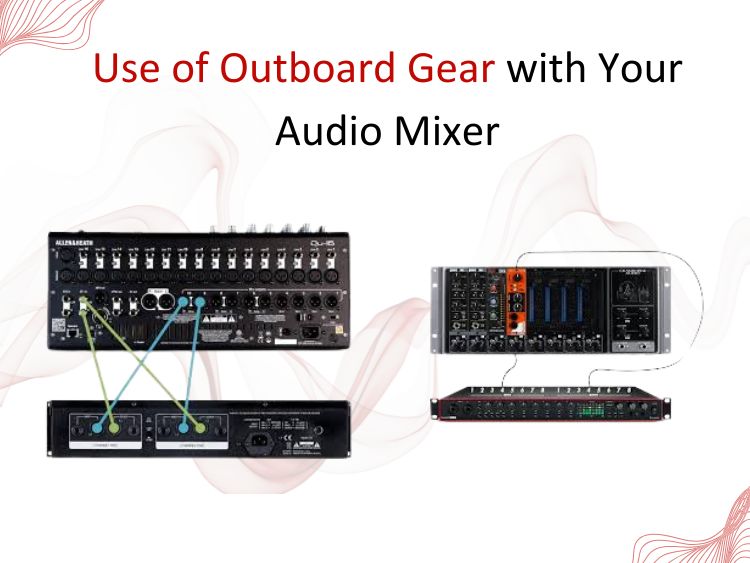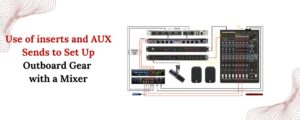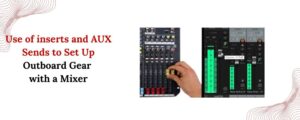Today, most of the mixing and processing work in music production is done “in the box”, which means it is achieved through the use of software plugins in a DAW (Digital Audio Workstation). While this has been the recent trend, numerous producers and engineers still tend to regard outboard gear as their go-to solution due to its color, warmth and the hands-on control it offers. From analog effects to preamps, compressors, and EQ units, adding outboard gear to your audio mixer will certainly elevate your sound.
This guide is designed for absolute beginners who want to learn the basics of connecting, configuring, and using outboard equipment with their audio mixer.
What Is Outboard Gear? Why Use It With a Mixer?
Outboard gear describes any external audio processing device that is not a part of your mixer or computer setup. The most popular include:
- Compressor: Dynamics Control and punch or glue are added to your tracks.
- Equalizers: Multiple filters sculpting the band’s frequency with analog elegance.
- Hardware Effects Units: Reverbs and delays that add ambiance and space.
- Preamps: The quality and level of a microphone and instruments are enhanced.
- Multi-Effect Processors: This blurs the distinction between modulation, time-based effects, and more.
From the above, outboard gear is the most relied on device for adding distinct colors that are hard to replicate digitally.
Your studio or live sound setup is typically controlled through audio mixers, which can be either analog or digital. Outboard gear can be used with your mixer for:
- Easier tone enhancements using analog circuitry.
- Processing less on your computer.
- Providing hands-on control over the effects chain.
- Enable sound design combinations that are impossible to achieve with plugins.
Lastly, it teaches effective signal flow which is a fundamental concept in audio engineering.
Setting Up Outboard Gear with Your Mixer
Using Inserts
- The Insert jacks on your mixer are meant to send and return audio using a single connection via a TRS (tip-ring-sleeve) cable, popularly known as an insert or Y cable.
- Plug the TRS end into the insert jack of the channel you want to modify.
- Send (usually the ring) is connected to the input of your outboard gear and Return (usually the tip) is connected to output of your gear.
- Ideal for compressors, EQ’s, and other effects which you want to apply 100% to a signal.
With Aux Sends and Returns
- An aux send can be used to send a part of a channel’s signal to an effect unit.
- An effect’s output either goes back into the mixer through return inputs or through a spare channel on the mixer, referred to as a return channel.
- This works well for reverb or delay effects where the mixer wants to blend the effect (the wet signal) into the original sound (the dry signal).
- Each channel aux send knob adjusts the level of the wet signal sent through the effect, and the channel fader controls the level of the dry signal.
Advice for Improved Outcomes
- Gain Staging: Carefully balance input and output levels. Make sure your mixer is compatible or utilize level-matching tools because outboard equipment frequently operates at line level (pro +4dBu or consumer -10dBV).
- Patch Bays: Take into account a patch bay if you intend to use several pieces of equipment. It streamlines and expedites routing.
- Noise Management: To lessen hum and interference, run audio away from power supply and, if at all possible, use balanced cables.
- Creative Routing: Try new things without fear. For distinctive textures, try using parallel processing or chaining effects in succession (EQ → compressor → reverb, for example).
Final Thoughts
In no way the use of outboard equipment with your mixer requires spending unreasonable amounts of money or owning an extensive collection of vintage equipment. Start with the basics — a standalone analog compressor or stereo reverb unit. It is not about replacing your DAW; rather, the aim is to provide your existing system with additional tools that enhance creativity, improve workflow, and improve sound.
Learning how to route, manage levels, and creatively use outboard effects will apply new respect for audio engineering skills and expand your sonic capabilities. The workflow becomes more hands-on and dynamic. Now go ahead and turn those dials and your mix will be grateful for it.



